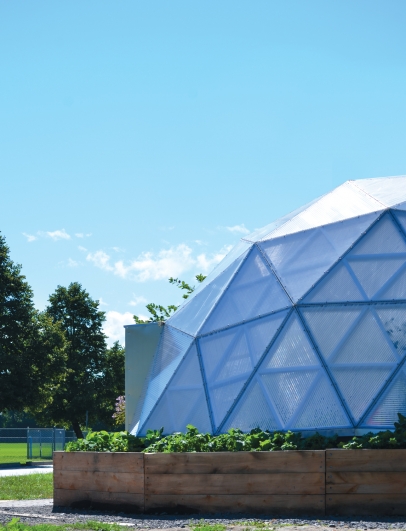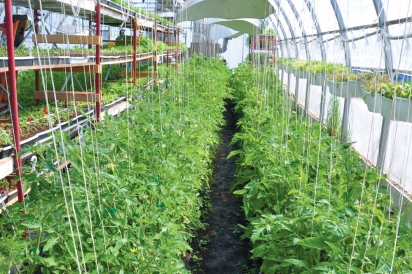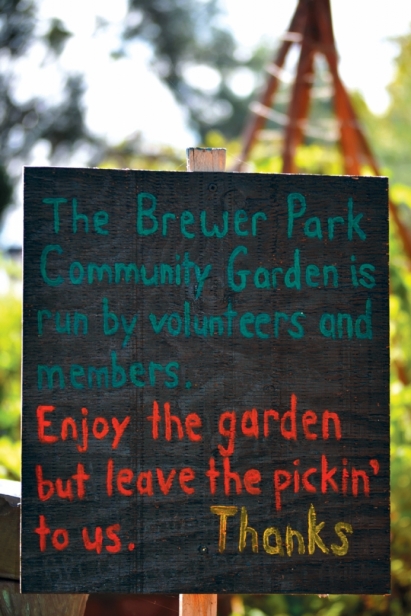Local Producers Explore Options for Extending the Season
We live in Eastern Ontario, we know the drill. Winter is long and every other season is short. We do not have much time to enjoy fresh, local produce before being forced to return, sadly, to imported fruit and vegetables that sometimes taste like cardboard. We simply do not have a choice. Or do we?
Producers across the Ottawa-Gatineau region are pursuing a variety of options to extend the season, from growing in climate- controlled spaces to storing and preserving harvested food to enjoy year-round.
It is a strategy whose time has come. The more we produce close to home, the more secure and sustainable the region’s food system will be. In addition, consumers will have more time to enjoy local food and producers will benefit as well.
Season extension offers farmers the chance for higher earnings, spread more evenly through the year. It also allows them to build relationships with customers over a longer period, increasing the likelihood of repeat business.
Stuart Collins, co-owner of Bryson Farms in Shawville, Quebec says simply, “If farmers can extend the season, they will.”
Options to extend the season include:
1. Growing in spaces that protect crops from extreme temperatures and weather conditions such as snow and high winds. The growing space can be as simple as a floating row cover or as sophisticated as a geodesic dome. Whatever the structure, the goal is to start producing earlier in the year than our climate usually permits, and to continue later.
2. Creating storage facilities that prolong the life of harvested produce.
3. Making use of non-traditional food sources, such as wild herbs, edible flowers and other plants that are available as long as the ground remains unfrozen.
4. Preserving fresh food through basic processing such as freezing, drying and pickling.
GREENHOUSES AND TUNNELS
Ferme Lève-tôt, a certified-organic Community Supported Agriculture (CSA) operation in Low, Quebec is one of many farms in the region that uses a heated greenhouse to stretch the growing season.
“It’s fairly low-tech, but it works,” says Richard Williams, who runs the farm with his wife, Charlotte Scott. “It has two layers of plastic so we can vary the amount of insulation by adding or removing a layer. An inflation fan creates an insulating air space between the plastic layers, and a furnace provides heat in the spring.”
The greenhouse is pressed into service year-round; it is used to start seedlings, grow early greens, cure winter squash and over-winter spinach and kale. “We'd like to use it more intensively in the future, without sacrificing our seedling production,” adds Richard.
To grow heat-loving crops from May to October, Lève-tôt uses four, easy-assembly seven foot by 12 foot caterpillar tunnels. Because they cannot withstand a snow load, the tunnels’ plastic covers are removed in winter and put back on in April to protect new plantings of beets, lettuce, greens, radishes and other extra-early, cold-tolerant crops. By May, those crops can be uncovered safely, so the tunnels are dismantled and moved elsewhere in the field, beginning the cycle again.
For plants like cucumbers and tomatoes that need more greenhouse cultivation, Richard and Charlotte rely on a high tunnel, or hoop house. They also employ floating row covers to shelter field crops in spring and fall and insulate over-wintering and extra-early/late crops.
In addition, Lève-tôt maintains a root cellar. Dug into a hillside, it keeps summer veggies super-fresh for markets and weekly CSA baskets. In fall, the cellar stores late-season crops such as carrots, onions and cabbages.
These combined methods make it possible for Richard and Charlotte to offer produce to their CSA members from June through late October, with the option of a fall storage basket in mid-November. “In coming years, we want to grow more fall and winter root vegetables,” explains Richard. “There’s no sense in having carrots coming in from California. It’s not that we can’t grow them in this part of the world; it’s that we don’t grow enough of them.”
SCALING UP
Bryson Farms uses similar techniques, but on a larger scale, to provide certified-organic, fresh and processed food to about 1,000 families year-round. I learned more by touring the operation’s two greenhouses, multiple high tunnels, and storage and processing units, accompanied by the energetic Stuart Collins.
The greenhouses grow early varieties of summer vegetables, off-peak salad and cooking greens, year-round micro-greens and winter-hardy lettuce, he tells me. “In winter, every square inch is filled with lettuce. There’s not much else you can grow at that time of year without big heating bills.” In one of the greenhouses, he shows off a germination chamber that can kick-start tens of thousands seedlings at a time.
For tall, heat-loving crops, such as heirloom tomatoes, the farm uses three unheated high tunnels, 60 feet long and 15 feet high. When those crops are done, they are replaced by arugula, chard and other greens until snow settles in for the winter. Five smaller walk-through tunnels were set up this fall for very early and very late crops. The beauty of the tunnels, says Stuart, is that they are fairly inexpensive, provide consistent heat and allow production into November and even December.
A variety of climate-controlled storage maximizes the life of harvested crops. If produce cannot be sold, it is flash-frozen, canned – including Bryson’s popular Just Tomatoes line – or incorporated into farm-brand frozen dishes, all prepared on-site. With a one-year shelf life, products ranging from sweet corn and squash-apple cider soup to heirloom pasta sauce and classic pumpkin pie can be enjoyed year-round, without loss of flavour or nutrition.
TRANSFORMING FOOD
Another way to extend the season is to transform food by preserving it, says horticulture and culinary consultant Roxane Robillard.
The owner of Fleurs Gourmandes, Roxane is a micro-processor who creates tisanes, jellies and pickles from edible plants that she forages, grows in her own garden or collects from her brother’s farm. Her products run the gamut from charred pepper jelly and cedar compote to sundried tomatoes, rhubarb ketchup and even pickled milkweed pods. You can find them at Cardamom and Cloves, Mariposa, and Savour Ottawa
online.
Finding and transforming wild foods means being able to eat fresh produce before and after traditional crops are ready, says Roxane. “The problem is we don’t recognize wild foods when we see them. Nor do we know what to do with them. As a consultant, I help people find what they can safely eat in their own backyards. Extending the food season means learning how to harvest anything, how to forage, how to can and dry food – in other words how to make the most of what’s available,” she adds. “We’re losing these arts, but they’re essential to survival.”
EXPLORING THE FUTURE OF FOOD
We may be able to extend the growing season, but will we ever be able to grow year-round?
Something called a biodome garden may offer the answer. Earlier this year, Brewer Park Community Garden in Old Ottawa South unveiled its own biodome garden to test the potential of year-round farming, as well as to contribute to food security and community development. Enclosed in an eye-catching, custom-built geodesic dome, the garden will integrate raised-bed vegetable production and fish farming via a system known as aquaponics.
Geodesic domes are well-suited to cultivating food in harsh weather. They are strong enough to withstand heavy snow and wind, and their shape makes the most of incoming sunlight, says the builder of Brewer Park’s dome, Martin Buffam of Future Foods Biodome Systems. “In the face of climate change and the almost biblical weather we’ve been having lately, it provides a protected ecosystem for growing clean, fresh food, including edible fish, in a very low-impact way.”
Although there are biodome gardens in Europe, this is the first in Eastern Canada, says project co-lead Guy Soulière. “If this garden is efficient, it could result in many more being built here, growing local produce in different ways and increasing access to fresh, nutritious food.”
This is, after all, what we want – as many chances as possible to enjoy the delicious, healthy foods of an Eastern Ontario growing season for as long as we can. No imported produce required.
EAT LOCAL FOR LONGER
Where can you find CSA farmers who offer a winter basket, producers who pickle or otherwise preserve summer’s bounty or food retailers that sell fresh or processed local foods? Check out Edible Ottawa’s online resource at edibleottawa.co. And remember you can shop for locally-produced food through Savour Ottawa’s new online marketplace at savourottawaonline.ca.







